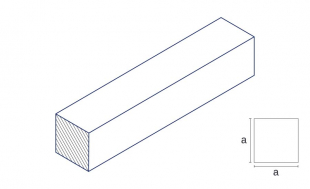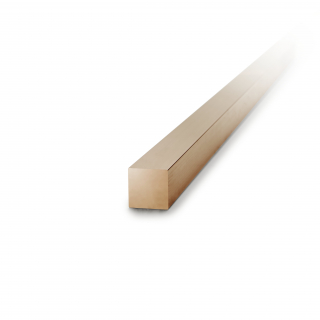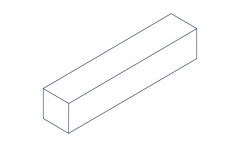-
Aviation
-
Chemical specifications
|
Cr (from)
|
0,5
|
|
Cr (to)
|
1,2
|
|
Fe (from)
|
0,08
|
|
Fe (to)
|
0,08
|
|
Other
|
0,2
|
|
Rest
|
Cu
|
|
Si (to)
|
0,1
|
|
Zr (from)
|
0,03
|
|
Zr (to)
|
0,3
|
-
Food industry
|
suitable according to DIN EN 602
|
No
|
-
Material
|
Material chemically EN 573-3
|
CuCr1Zr
|
|
Material no
|
CW106C (former: 2.1293)
|
-
physical properties
|
Coefficient of thermal expansion from 20 to 100°C
|
16.3 K⁻¹10⁻⁶
|
|
Coefficient of thermal expansion from 20 to 200°C
|
17 K⁻¹10⁻⁶
|
|
Coefficient of thermal expansion from 20 to 300°C
|
17.6 K⁻¹10⁻⁶
|
|
Density
|
8.91 g/cm³
|
|
Modulus of elasticity at 20°C
|
90 GPa
|
|
Specific electrical conductivity at 100°C
|
36 m/Ω*mm²
|
|
Specific electrical conductivity at 20°C
|
43 m/Ω*mm²
|
|
Specific electrical conductivity at 200°C
|
28 m/Ω*mm²
|
|
Specific electrical resistance at 100°C
|
0.028 Ω*mm²/m
|
|
Specific electrical resistance at 20°C
|
0.023 Ω*mm²/m
|
|
Specific electrical resistance at 200°C
|
0.036 Ω*mm²/m
|
|
Specific heat at 100°C
|
0.45 J/(kg·K)
|
|
Specific heat at 20°C
|
0.37 J/(kg·K)
|
|
Specific heat at 200°C
|
0.48 J/(kg·K)
|
|
Specific heat at -200°C
|
0 J/(kg·K)
|
|
Thermal conductivity at 100°C
|
315 W/m*K
|
|
Thermal conductivity at 20°C
|
330 W/m*K
|
|
Thermal conductivity at 200°C
|
324 W/m*K
|
-
Welding
|
Gas
|
6
|
|
MIG
|
5
|
|
Resistance spot welding
|
2
|
|
TIG
|
5
|
-
Aviation
-
Chemical specifications
|
Cr (from)
|
0,5
|
|
Cr (to)
|
1,2
|
|
Fe (from)
|
0,08
|
|
Fe (to)
|
0,08
|
|
Other
|
0,2
|
|
Rest
|
Cu
|
|
Si (to)
|
0,1
|
|
Zr (from)
|
0,03
|
|
Zr (to)
|
0,3
|
-
Food industry
|
suitable according to DIN EN 602
|
No
|
-
Material
|
Material chemically EN 573-3
|
CuCr1Zr
|
|
Material no
|
CW106C (former: 2.1293)
|
-
physical properties
|
Coefficient of thermal expansion from 20 to 100°C
|
16.3 K⁻¹10⁻⁶
|
|
Coefficient of thermal expansion from 20 to 200°C
|
17 K⁻¹10⁻⁶
|
|
Coefficient of thermal expansion from 20 to 300°C
|
17.6 K⁻¹10⁻⁶
|
|
Density
|
8.91 g/cm³
|
|
Modulus of elasticity at 20°C
|
90 GPa
|
|
Specific electrical conductivity at 100°C
|
36 m/Ω*mm²
|
|
Specific electrical conductivity at 20°C
|
43 m/Ω*mm²
|
|
Specific electrical conductivity at 200°C
|
28 m/Ω*mm²
|
|
Specific electrical resistance at 100°C
|
0.028 Ω*mm²/m
|
|
Specific electrical resistance at 20°C
|
0.023 Ω*mm²/m
|
|
Specific electrical resistance at 200°C
|
0.036 Ω*mm²/m
|
|
Specific heat at 100°C
|
0.45 J/(kg·K)
|
|
Specific heat at 20°C
|
0.37 J/(kg·K)
|
|
Specific heat at 200°C
|
0.48 J/(kg·K)
|
|
Specific heat at -200°C
|
0 J/(kg·K)
|
|
Thermal conductivity at 100°C
|
315 W/m*K
|
|
Thermal conductivity at 20°C
|
330 W/m*K
|
|
Thermal conductivity at 200°C
|
324 W/m*K
|
-
Welding
|
Gas
|
6
|
|
MIG
|
5
|
|
Resistance spot welding
|
2
|
|
TIG
|
5
|
-
Aviation
-
Chemical specifications
|
Cr (from)
|
0,5
|
|
Cr (to)
|
1,2
|
|
Fe (from)
|
0,08
|
|
Fe (to)
|
0,08
|
|
Other
|
0,2
|
|
Rest
|
Cu
|
|
Si (to)
|
0,1
|
|
Zr (from)
|
0,03
|
|
Zr (to)
|
0,3
|
-
Food industry
|
suitable according to DIN EN 602
|
No
|
-
Material
|
Material chemically EN 573-3
|
CuCr1Zr
|
|
Material no
|
CW106C (former: 2.1293)
|
-
physical properties
|
Coefficient of thermal expansion from 20 to 100°C
|
16.3 K⁻¹10⁻⁶
|
|
Coefficient of thermal expansion from 20 to 200°C
|
17 K⁻¹10⁻⁶
|
|
Coefficient of thermal expansion from 20 to 300°C
|
17.6 K⁻¹10⁻⁶
|
|
Density
|
8.91 g/cm³
|
|
Modulus of elasticity at 20°C
|
90 GPa
|
|
Specific electrical conductivity at 100°C
|
36 m/Ω*mm²
|
|
Specific electrical conductivity at 20°C
|
43 m/Ω*mm²
|
|
Specific electrical conductivity at 200°C
|
28 m/Ω*mm²
|
|
Specific electrical resistance at 100°C
|
0.028 Ω*mm²/m
|
|
Specific electrical resistance at 20°C
|
0.023 Ω*mm²/m
|
|
Specific electrical resistance at 200°C
|
0.036 Ω*mm²/m
|
|
Specific heat at 100°C
|
0.45 J/(kg·K)
|
|
Specific heat at 20°C
|
0.37 J/(kg·K)
|
|
Specific heat at 200°C
|
0.48 J/(kg·K)
|
|
Specific heat at -200°C
|
0 J/(kg·K)
|
|
Thermal conductivity at 100°C
|
315 W/m*K
|
|
Thermal conductivity at 20°C
|
330 W/m*K
|
|
Thermal conductivity at 200°C
|
324 W/m*K
|
-
Welding
|
Gas
|
6
|
|
MIG
|
5
|
|
Resistance spot welding
|
2
|
|
TIG
|
5
|
-
Aviation
-
Chemical specifications
|
Cr (from)
|
0,5
|
|
Cr (to)
|
1,2
|
|
Fe (from)
|
0,08
|
|
Fe (to)
|
0,08
|
|
Other
|
0,2
|
|
Rest
|
Cu
|
|
Si (to)
|
0,1
|
|
Zr (from)
|
0,03
|
|
Zr (to)
|
0,3
|
-
Food industry
|
suitable according to DIN EN 602
|
No
|
-
Material
|
Material chemically EN 573-3
|
CuCr1Zr
|
|
Material no
|
CW106C (former: 2.1293)
|
-
physical properties
|
Coefficient of thermal expansion from 20 to 100°C
|
16.3 K⁻¹10⁻⁶
|
|
Coefficient of thermal expansion from 20 to 200°C
|
17 K⁻¹10⁻⁶
|
|
Coefficient of thermal expansion from 20 to 300°C
|
17.6 K⁻¹10⁻⁶
|
|
Density
|
8.91 g/cm³
|
|
Modulus of elasticity at 20°C
|
90 GPa
|
|
Specific electrical conductivity at 100°C
|
36 m/Ω*mm²
|
|
Specific electrical conductivity at 20°C
|
43 m/Ω*mm²
|
|
Specific electrical conductivity at 200°C
|
28 m/Ω*mm²
|
|
Specific electrical resistance at 100°C
|
0.028 Ω*mm²/m
|
|
Specific electrical resistance at 20°C
|
0.023 Ω*mm²/m
|
|
Specific electrical resistance at 200°C
|
0.036 Ω*mm²/m
|
|
Specific heat at 100°C
|
0.45 J/(kg·K)
|
|
Specific heat at 20°C
|
0.37 J/(kg·K)
|
|
Specific heat at 200°C
|
0.48 J/(kg·K)
|
|
Specific heat at -200°C
|
0 J/(kg·K)
|
|
Thermal conductivity at 100°C
|
315 W/m*K
|
|
Thermal conductivity at 20°C
|
330 W/m*K
|
|
Thermal conductivity at 200°C
|
324 W/m*K
|
-
Welding
|
Gas
|
6
|
|
MIG
|
5
|
|
Resistance spot welding
|
2
|
|
TIG
|
5
|
-
Aviation
-
Chemical specifications
|
Cr (from)
|
0,5
|
|
Cr (to)
|
1,2
|
|
Fe (from)
|
0,08
|
|
Fe (to)
|
0,08
|
|
Other
|
0,2
|
|
Rest
|
Cu
|
|
Si (to)
|
0,1
|
|
Zr (from)
|
0,03
|
|
Zr (to)
|
0,3
|
-
Food industry
|
suitable according to DIN EN 602
|
No
|
-
Material
|
Material chemically EN 573-3
|
CuCr1Zr
|
|
Material no
|
CW106C (former: 2.1293)
|
-
physical properties
|
Coefficient of thermal expansion from 20 to 100°C
|
16.3 K⁻¹10⁻⁶
|
|
Coefficient of thermal expansion from 20 to 200°C
|
17 K⁻¹10⁻⁶
|
|
Coefficient of thermal expansion from 20 to 300°C
|
17.6 K⁻¹10⁻⁶
|
|
Density
|
8.91 g/cm³
|
|
Modulus of elasticity at 20°C
|
90 GPa
|
|
Specific electrical conductivity at 100°C
|
36 m/Ω*mm²
|
|
Specific electrical conductivity at 20°C
|
43 m/Ω*mm²
|
|
Specific electrical conductivity at 200°C
|
28 m/Ω*mm²
|
|
Specific electrical resistance at 100°C
|
0.028 Ω*mm²/m
|
|
Specific electrical resistance at 20°C
|
0.023 Ω*mm²/m
|
|
Specific electrical resistance at 200°C
|
0.036 Ω*mm²/m
|
|
Specific heat at 100°C
|
0.45 J/(kg·K)
|
|
Specific heat at 20°C
|
0.37 J/(kg·K)
|
|
Specific heat at 200°C
|
0.48 J/(kg·K)
|
|
Specific heat at -200°C
|
0 J/(kg·K)
|
|
Thermal conductivity at 100°C
|
315 W/m*K
|
|
Thermal conductivity at 20°C
|
330 W/m*K
|
|
Thermal conductivity at 200°C
|
324 W/m*K
|
-
Welding
|
Gas
|
6
|
|
MIG
|
5
|
|
Resistance spot welding
|
2
|
|
TIG
|
5
|
-
Aviation
-
Chemical specifications
|
Cr (from)
|
0,5
|
|
Cr (to)
|
1,2
|
|
Fe (from)
|
0,08
|
|
Fe (to)
|
0,08
|
|
Other
|
0,2
|
|
Rest
|
Cu
|
|
Si (to)
|
0,1
|
|
Zr (from)
|
0,03
|
|
Zr (to)
|
0,3
|
-
Food industry
|
suitable according to DIN EN 602
|
No
|
-
Material
|
Material chemically EN 573-3
|
CuCr1Zr
|
|
Material no
|
CW106C (former: 2.1293)
|
-
physical properties
|
Coefficient of thermal expansion from 20 to 100°C
|
16.3 K⁻¹10⁻⁶
|
|
Coefficient of thermal expansion from 20 to 200°C
|
17 K⁻¹10⁻⁶
|
|
Coefficient of thermal expansion from 20 to 300°C
|
17.6 K⁻¹10⁻⁶
|
|
Density
|
8.91 g/cm³
|
|
Modulus of elasticity at 20°C
|
90 GPa
|
|
Specific electrical conductivity at 100°C
|
36 m/Ω*mm²
|
|
Specific electrical conductivity at 20°C
|
43 m/Ω*mm²
|
|
Specific electrical conductivity at 200°C
|
28 m/Ω*mm²
|
|
Specific electrical resistance at 100°C
|
0.028 Ω*mm²/m
|
|
Specific electrical resistance at 20°C
|
0.023 Ω*mm²/m
|
|
Specific electrical resistance at 200°C
|
0.036 Ω*mm²/m
|
|
Specific heat at 100°C
|
0.45 J/(kg·K)
|
|
Specific heat at 20°C
|
0.37 J/(kg·K)
|
|
Specific heat at 200°C
|
0.48 J/(kg·K)
|
|
Specific heat at -200°C
|
0 J/(kg·K)
|
|
Thermal conductivity at 100°C
|
315 W/m*K
|
|
Thermal conductivity at 20°C
|
330 W/m*K
|
|
Thermal conductivity at 200°C
|
324 W/m*K
|
-
Welding
|
Gas
|
6
|
|
MIG
|
5
|
|
Resistance spot welding
|
2
|
|
TIG
|
5
|
-
Aviation
-
Chemical specifications
|
Cr (from)
|
0,5
|
|
Cr (to)
|
1,2
|
|
Fe (from)
|
0,08
|
|
Fe (to)
|
0,08
|
|
Other
|
0,2
|
|
Rest
|
Cu
|
|
Si (to)
|
0,1
|
|
Zr (from)
|
0,03
|
|
Zr (to)
|
0,3
|
-
Food industry
|
suitable according to DIN EN 602
|
No
|
-
Material
|
Material chemically EN 573-3
|
CuCr1Zr
|
|
Material no
|
CW106C (former: 2.1293)
|
-
physical properties
|
Coefficient of thermal expansion from 20 to 100°C
|
16.3 K⁻¹10⁻⁶
|
|
Coefficient of thermal expansion from 20 to 200°C
|
17 K⁻¹10⁻⁶
|
|
Coefficient of thermal expansion from 20 to 300°C
|
17.6 K⁻¹10⁻⁶
|
|
Density
|
8.91 g/cm³
|
|
Modulus of elasticity at 20°C
|
90 GPa
|
|
Specific electrical conductivity at 100°C
|
36 m/Ω*mm²
|
|
Specific electrical conductivity at 20°C
|
43 m/Ω*mm²
|
|
Specific electrical conductivity at 200°C
|
28 m/Ω*mm²
|
|
Specific electrical resistance at 100°C
|
0.028 Ω*mm²/m
|
|
Specific electrical resistance at 20°C
|
0.023 Ω*mm²/m
|
|
Specific electrical resistance at 200°C
|
0.036 Ω*mm²/m
|
|
Specific heat at 100°C
|
0.45 J/(kg·K)
|
|
Specific heat at 20°C
|
0.37 J/(kg·K)
|
|
Specific heat at 200°C
|
0.48 J/(kg·K)
|
|
Specific heat at -200°C
|
0 J/(kg·K)
|
|
Thermal conductivity at 100°C
|
315 W/m*K
|
|
Thermal conductivity at 20°C
|
330 W/m*K
|
|
Thermal conductivity at 200°C
|
324 W/m*K
|
-
Welding
|
Gas
|
6
|
|
MIG
|
5
|
|
Resistance spot welding
|
2
|
|
TIG
|
5
|
-
Aviation
-
Chemical specifications
|
Cr (from)
|
0,5
|
|
Cr (to)
|
1,2
|
|
Fe (from)
|
0,08
|
|
Fe (to)
|
0,08
|
|
Other
|
0,2
|
|
Rest
|
Cu
|
|
Si (to)
|
0,1
|
|
Zr (from)
|
0,03
|
|
Zr (to)
|
0,3
|
-
Food industry
|
suitable according to DIN EN 602
|
No
|
-
Material
|
Material chemically EN 573-3
|
CuCr1Zr
|
|
Material no
|
CW106C (former: 2.1293)
|
-
physical properties
|
Coefficient of thermal expansion from 20 to 100°C
|
16.3 K⁻¹10⁻⁶
|
|
Coefficient of thermal expansion from 20 to 200°C
|
17 K⁻¹10⁻⁶
|
|
Coefficient of thermal expansion from 20 to 300°C
|
17.6 K⁻¹10⁻⁶
|
|
Density
|
8.91 g/cm³
|
|
Modulus of elasticity at 20°C
|
90 GPa
|
|
Specific electrical conductivity at 100°C
|
36 m/Ω*mm²
|
|
Specific electrical conductivity at 20°C
|
43 m/Ω*mm²
|
|
Specific electrical conductivity at 200°C
|
28 m/Ω*mm²
|
|
Specific electrical resistance at 100°C
|
0.028 Ω*mm²/m
|
|
Specific electrical resistance at 20°C
|
0.023 Ω*mm²/m
|
|
Specific electrical resistance at 200°C
|
0.036 Ω*mm²/m
|
|
Specific heat at 100°C
|
0.45 J/(kg·K)
|
|
Specific heat at 20°C
|
0.37 J/(kg·K)
|
|
Specific heat at 200°C
|
0.48 J/(kg·K)
|
|
Specific heat at -200°C
|
0 J/(kg·K)
|
|
Thermal conductivity at 100°C
|
315 W/m*K
|
|
Thermal conductivity at 20°C
|
330 W/m*K
|
|
Thermal conductivity at 200°C
|
324 W/m*K
|
-
Welding
|
Gas
|
6
|
|
MIG
|
5
|
|
Resistance spot welding
|
2
|
|
TIG
|
5
|
1 very good
2 good
3 moderate
4 poor
5 unsuited
0 Not specified






